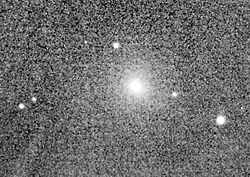Comet Grigg-Skjellerup
 |
|
| Discovery | |
|---|---|
| Discovered by | John Grigg and John Francis Skjellerup |
| Discovery date | 1902 and 1922 |
| Alternative designations |
1808 C1; 1808 III; 1902 O1; 1902 II; 1902c; 1922 K1; 1922 I; 1922b; 1927 F1; 1927 V; 1927e; 1932 II; 1932d; 1937 III; 1937e; 1942 V; 1942d; 1947 II; 1947a; 1952 IV; 1952b; 1957 I; 1956i; 1961 IX; 1961g; 1967 I; 1966f; 1972 II; 1972b; 1977 VI; 1977b; 1982 IV; 1982a; 1987 X; 1986m; 1992 XVIII |
| Orbital characteristics A | |
| Epoch | April 10, 2007 (JD 2454200.5) |
| Aphelion | 4.9332 AU |
| Perihelion | 1.1168 AU |
| Semi-major axis | 3.0437 AU |
| Eccentricity | 0.6631 |
| Orbital period | 5.31 a |
| Inclination | 22.36° |
| Earth MOID | 0.079 AU (11,800,000 km) |
| Last perihelion | July 6, 2013 March 23, 2008 |
| Next perihelion | 2018-Oct-01 |
Comet Grigg–Skjellerup (formally designated 26P/Grigg–Skjellerup) is a periodic comet. It was visited by the Giotto probe in July 1992. It came as close as 200 km, but could not take pictures because some instruments were damaged from its encounter with Halley's Comet.
Discovered in 1902 by John Grigg of New Zealand, and rediscovered in its next appearance in 1922 by John Francis Skjellerup, an Australian then living and working for about two decades in South Africa where he was a founder member of the Astronomical Society of Southern Africa.
In 1987, it was belatedly discovered by Ľubor Kresák that the comet had been observed in 1808 as well, by Jean-Louis Pons.
The comet has often suffered the gravitational influence of Jupiter, which has altered its orbit considerably. For instance, its perihelion distance has changed from 0.77 AU in 1725 to 0.89 AU in 1922 to 0.99 AU in 1977 and to 1.12 AU in 1999.
Having its recent perihelion so close to Earth's orbit made it an easy target to reach for the Giotto mission (spacecraft) in 1992, whose primary mission was to Comet Halley. Giotto had a closest approach to Grigg–Skjellerup of 200 km, much closer than its approach to Comet Halley, but was unable to obtain images as its camera was destroyed during the Halley rendezvous in 1986.
In 1972 the comet was discovered to produce a meteor shower, the Pi Puppids, and its current orbit makes them peak around April 23, for observers in the southern hemisphere, best seen when the comet is near perihelion.
...
Wikipedia
